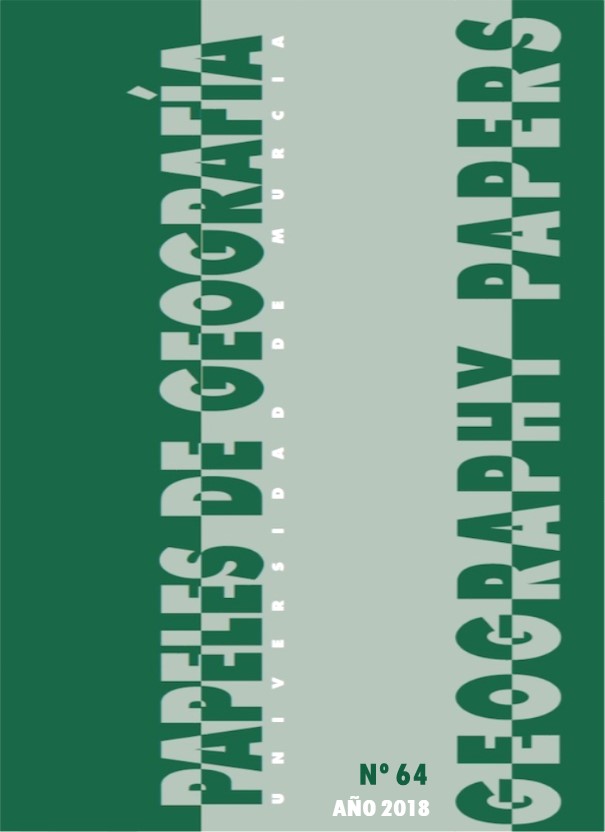Efecto de la subdivisión de cuencas y la estimación de variables climáticas en la simulación de componentes de balance hídrico en cuencas semiáridas mediterráneas
Agencias de apoyo
- Instituto Euromediterráneo del Agua
- CARM
Resumen
Los resultados de cualquier intento de modelización hidrológica dependen de la calidad y discretización de los datos de entrada. En este trabajo se evalúa cómo la utilización de diferentes capas de variables climáticas de entrada (precipitación y ETP) y diferentes esquemas de discretización de la cuenca influyen en los resultados de un modelo hidrológico bien conocido (SWAT). En concreto se prueban 4 conjuntos de variables de entrada y discretización. Los estadísticos utilizados para evaluar la exactitud obtenida con estos conjuntos son RMSE, PBIAS, NSE y r2. Los resultados muestran que el uso de mejores modelos para obtener series de ETP (Penman Monteith FAO o Hargreaves calibrado) mejora considerablemente la exactitud del modelo respecto a las series obtenidas con el modelo de Hargreaves sin calibrar (opción por defecto en SWAT). Sin embargo, no se aprecian diferencias entre los resultados obtenidos con Penman Monteith FAO y Hargreaves calibrado. Por otro lado, el uso de información climática distribuida mejora notablemente los resultados obtenidos con información agregada. Se observa también la necesidad de calibrar los parámetros de SWAT ya que los valores por defecto están optimizados para ambientes templados de EEUU.
Descargas
-
Resumen629
-
PDF871
Citas
ABBASPOUR, K.C., ROUHOLAHNEJAD, E., VAGHEFI, S., SRINIVASAN, R., YANG, H. y KLØVE, B. (2015): “A continental-scale hydrology and water quality model for Europe: Calibration and uncertainty of a high-resolution large-scale SWAT model”. Journal of Hydrology, vol. 524, p. 733–752.
ABBASPOUR, K.C., YANG, J., MAXIMOV, I., SIBER, R., BOGNER, K., MIELEITNER, J., ZOBRIST, J. y SRINIVASAN, R. (2007): “Modelling hydrology and water quality in the pre-alpine/alpine Thur watershed using SWAT”. Journal of Hidrology, vol. 333, p. 413–430.
ALLEN, R.G. (1986): “A Penman for all seasons”. Journal of Irrigation and Drainage Engineering, vol. 112, p. 348–368.
ALLEN, R.G., SMITH, M., PERRIE, M. y PEREIRA, L.S. (1994): “An update for the calculation of reference evapotranspiration”. ICID Bulletin, vol. 43, nº 2, p. 35–92.
ARNOLD, J.G., ENGEL, B.A. y SRINIVASAN, R. (1993): Application of Advanced Information Technologies for Management of Natural Resources. “A continuous time, grid cell watershed model”. En ASAE (Ed.) , Spokane, Washington, pp. 17–19.
BOE. (2007): “Acuerdo para encomienda de gestión por el MAAMA (Dirección General del Agua) al CEDEX, del Ministerio de Fomento, para la realización de asistencia técnica, investigación y desarrollo tecnológico en materias competencia de la Dirección General del Agua”. Boletín Oficial del Estado, Gobierno de España. Madrid.
BRU RONDA, C. (1993): “La sobreexplotación de acuíferos y los planes de ordenación hidráulica en la cuenca del río Vinalopó, Alicante”. Investigaciones Geográficas, vol. 11, p. 93–107.
C.H.J. (2015): Plan Hidrológico de La Demarcación Hidrográfica Del Júcar. Ciclo de Planificación Hidrológica 2015-2021. Confederación Hidrográfica del Júcar, Gobierno de España. Madrid.
CHIANG, L.C. y YUAN, Y. (2015): “The NHDPlus dataset, watershed subdivision and SWAT model performance”. Hydrological Sciences Journal, vol. 60, p. 1690–1708.
DILE, Y.T., DAGGUPATI, P., GEORGE, C., SRINIVASAN, R. y ARNOLD, J. (2016): “Introducing a new open source GIS user interface for the SWAT model”. Environmental Modelling and Software, vol. 85, p. 129–138.
DONG, X. (2013): Conference Proceedings of SWAT 2013. “Moulding SWAT model for Chines Qingjiang river for rainfall-runoff simulations”. Texas Water Resources Institute Technical Report.
DOUGLAS-MANKIN, K.R., SRINIVASAN, R. y ARNOLD, J.G. (2010): “Soil and water assessment tool (SWAT) model: Current developments and applications”. Transactions of the ASABE, vol. 53, nº 5, p. 1423–1431.
ESTRELA, T. y QUINTAS, L. (1996): “El sistema integrado de modelización precipitación-aportación SIMPA”. Ingeniería Civil, vol. 104, p. 43–52.
FAO, IIASA, ISRIC, ISSCAS y JRC. (2012): Harmonized World Soil Database (vs 1.2), FAO, Rome, Italy and IIASA. Laxenburg, Austria.
GASSMAN, P.W., REYES, M.R., GREEN, C.H. y ARNOLD, J.G. (2007): “The Soil and Water Assesment Tool: historical development, applications and future research directions”. Transactions of the ASAE, vol. 50, p. 1221–1250.
GITHUI, F. y THAYALAKUMARAN, T. (2011): 1The 19th International Congress on Modelling and Simulation (MODSIM2011). “The effect of discretization of hydrologic response units on the performance of SWAT model in simulating flow and evapotranspiration Githuia and Thayalakumaran, The effect of discretization of hydrologic response units on the performance of SWAT model in”. En Wongsosaputro, J., Pauwels, L.L. y Chan, F. (Ed.). Perth, Australia, pp. 3412–3418.
GOMARIZ-CASTILLO, F. y ALONSO-SARRÍA, F. (2013): The 9th International R User Conference. “An R script to model monthly climatic variables with GLM to be used in hydrological modeling in River Segura basin”. University of Castilla-La Mancha, Albacete, Castilla-La Mancha.
GOMARIZ-CASTILLO, F., ALONSO-SARRÍA, F. y CABEZAS, F. (2017): “Calibration and spatial modelling of daily ET0 in semiarid areas using Hargreaves equation”. Earth Science Information, En prensa, p. 1–16.
GOMARIZ-CASTILLO, F., ALONSO-SARRÍA, F. y CÁNOVAS-GARCÍA, F. (2017): “Improving Classification Accuracy of Multi-Temporal Landsat Images by Assessing the Use of Different Algorithms, Textural and Ancillary Information for a Mediterranean Semiarid Area from 2000 to 2015”. Remote Sensing, vol. 9, nº 10, p. 1–23.
GONG, Y., SHEN, Z., LIU, R., WANG, X. y CHEN, T. (2010): “Effect of Watershed Subdivision on SWAT Modeling with Consideration of Parameter Uncertainty”. Journal of Hydrologic Engineering, vol. 15, p. 1070–1074.
HARGREAVES, G.H. y ALLEN, R.G. (2003): “History and evaluation of Hargreaves evapotranspiration equation”. Journal of Irrigation and Drainage Engineering-Asce, vol. 129, p. 53–63.
HARGREAVES, G.H. y SAMANI, Z.A. (1985): “Reference crop evapotranspiration from temperature”. Applied Engineering in Agriculture, vol. 1, p. 96–99.
JAJARMIZADEH, M., SIDEK, L.M., HARUN, S. y SALARPOUR, M. (2017): “Optimal Calibration and Uncertainty Analysis of SWAT for an Arid Climate”. Air, Soil and Water Research, vol 10, p. 1–14.
JHA, M., GASSMAN, P.W., SECCHI, S., GU, R. y ARNOLD, J. (2004): “Effect of watershed subdivision on swat flow, sediment, y nutrient predictions”. Journal of the American Water Resources Association, vol. 40, p. 811–825.
KUMAR, M., BHATT, G. y DUFFY, C.J. (2009): “An efficient domain decomposition framework for accurate representation of geodata in distributed hydrologic models”. International Journal of Geographical Information Science, vol. 23, p. 1569–1596.
LEGATES, D.R. y MCCABE, G.J. (1999): “Evaluating the use of ‘goodness-of-fit’ measures in hydrologic and hydroclimatic model validation”. Water Resources Research, vol. 35, p. 233–241.
MONTEITH, J.L. (1993): The State and Movement of Water in Living Organisms. 19 Symposia of the Society for Experimental Biology. “Evaporation and the environment”. Cambridge Univ. Press. London, U.K., pp. 205–234.
MORIASI, D.N., ARNOLD, J.G., VAN-LIEW, M.W., BINGNER, R.L., HARMEL, R.D. y VEITH, T.L. (2007): “Model evaluation guidelines for systematic quantification of accuracy in whatershed simulations”. Transactions of the ASAE, vol. 50, p. 885–900.
MUKUNDAN, R., RADCLIFFE, D.E. y RISSE, L.M. (2010): “Spatial resolution of soil data and channel erosion effects on SWAT model predictions of flow and sediment”. Journal of Soil and Water Conservation, vol. 65, p. 92–104.
NASH, J.E. y SUTCLIFFE, J. V. (1970): “River flow forecasting through conceptual models part I-A discussion of principles”. Journal of Hydrology, vol. 10, p. 282–290.
NEITSCH, S.L., ARNOLD, J.G., KINIRY, J.R. y WILLIAMS, J.R. (2011): Soil and Water Assessment Tool. Theoretical Documentation. Version 2009, Texas Water Resources Institute. Temple, Texas, pp. 618.
O’CALLAGHAN, J.F. y MARK, D.M. (1984): “The extraction of drainage networks from digital elevation data”. Computer Vision, Graphics and Image Processing, vol. 28, p. 328–344.
SAXTON, K. E. y RAWLS, W.J. (2006): “Soil Water Characteristic Estimates by Texture and Organic Matter for Hydrologic Solutions”. Soil Science Society of America Journal, vol. 70, p. 1569–1578.
TRIPATHI, M.P., RAGHUWANSHI, N.S. y RAO, G.P. (2006): “Effect of watershed subdivision on simulation of water balance components”. Hydrological Processes, vol. 20, p. 1137–1156.
TUO, Y., DUAN, Z., DISSE, M. y CHIOGNA, G. (2016): “Evaluation of precipitation input for SWAT modeling in Alpine catchment: A case study in the Adige river basin (Italy)”. Science of The Total Environment, vol. 573, p. 66–82.
WILLIAMS, J.R. (1969): “Flood routing with variable travel time or variable storage coefficients”. Transactions of ASAE, vol. 12, p. 100–103.
YANG, J., REICHERT, P., ABBASPOUR, K.C., XIA, J. y YANG, H. (2008): “Comparing uncertainty analisys techniques for a SWAT application to the Chaohe Basin in China”. Journal of Hydrology, vol. 358, p. 1–23.
YUAN, Y., NIE, W. y SANDERS, E. (2014): SEDHYD 2014 Joint Conference. “Problems and Prospects of SWAT Model Application on an Arid/Semi-arid Watershed in Arizona”. Reno, NV (US).
ZAMBRANO-BIGIARINI, M. y ROJAS, R. (2013): “A model-independent Particle Swarm Optimisation software for model calibration”. Environmental Modelling & Software, vol. 43, p. 5–25.
ZHANG, D., CHEN, X., YAO, H. y LIN, B. (2015): “Improved calibration scheme of SWAT by separating wet and dry seasons”. Ecological Modelling, Elsevier, vol. 301, p. 54–61.
Las obras que se publican en esta revista están sujetas a los siguientes términos:
1. El Servicio de Publicaciones de la Universidad de Murcia (la editorial) conserva los derechos patrimoniales (copyright) de las obras publicadas, y favorece y permite la reutilización de las mismas bajo la licencia de uso indicada en el punto 2.
2. Las obras se publican en la edición electrónica de la revista bajo una licencia Creative Commons Reconocimiento-NoComercial 4.0 (texto legal). Se pueden copiar, usar, difundir, transmitir y exponer públicamente, siempre que: i) se cite la autoría y la fuente original de su publicación (revista, editorial y URL de la obra); ii) no se usen para fines comerciales; iii) se mencione la existencia y especificaciones de esta licencia de uso.
3. Condiciones de auto-archivo. Se permite y se anima a los autores a difundir electrónicamente las versiones pre-print (versión antes de ser evaluada) y/o post-print (versión evaluada y aceptada para su publicación) de sus obras antes de su publicación, ya que favorece su circulación y difusión más temprana y con ello un posible aumento en su citación y alcance entre la comunidad académica. Color RoMEO: verde.








